Anchor Winches for Boats
Anchor winches for boats and operating an anchor winch or windlass correctly is essential for safe and efficient anchoring aboard yachts and sailboats. These mechanical devices—manual, electric, or hydraulic—are designed to deploy and retrieve anchor rode (chain or rope) with control and minimal strain. Proper use not only protects equipment but also enhances crew safety and anchoring precision.
Anchor Winches for Boats
Before anchoring, inspect the windlass system. Ensure the clutch is functional, the gypsy (chain wheel) is free of corrosion or damage, and the rode is flaked neatly in the locker. Confirm that the power supply is active (for electric/hydraulic units) and that the circuit breaker is on. Always have a manual backup plan in case of power failure.
Anchor Winches for Boats
Anchor Winches for Boats seems to cause many problems. So many times I have witnessed people using an anchor windlass incorrectly and doing serious damage to them. Typical anchor retrieval speeds are around 30ft/minute at around 200 lb loading, and higher loads will cause a slower anchor retrieval rate. Windlasses do not have a constant load during anchor recovery, but have a varying load according to the various phases of anchor recovery. When operating your anchor windlass please observe the following practices.
Anchor Winches for Boats Deployment
Position the vessel head-to-wind and slowly approach the intended anchoring spot. Disengage the clutch or use the down control to lower the anchor under gravity or power. Pay out the rode steadily, ensuring it doesn’t pile up or foul. Count or mark the chain to measure scope—typically 5:1 to 7:1 ratio of rode to depth for secure holding. Once the anchor is set, gently reverse the engine to test holding
Anchor Winches for Boats - Retrieval
To weigh anchor, motor slowly toward the anchor while retrieving the rode with the windlass. Avoid using the windlass to pull the boat forward—it’s designed to lift vertical loads, not tow the vessel. Use short bursts to prevent overheating. When the chain is vertical, pause and let the boat’s motion break the anchor free. Once aboard, secure the anchor with a chain stopper or snubber to relieve strain on the windlass.
Anchor Winches for Boats
The first phase involves slowly motoring up over the anchor so the recovery rate will be at a maximum speed. This removes chain tension and makes recovery quicker and less load on the windlass electric motor. The engine alternator supplies a good part of the motor windlass load and keeps the motor from impressing a large voltage surge (brown out) on the electrical system, and more importantly keeps the voltage from dropping too low. The same technique is used by big commercial ships as well.
The anchor windlass should never be used without motoring, the voltage drop can be severe so that a drop in power occurs after only a few minutes as even batteries have a hard time coping with such loads. If the anchor becomes fouled take the load on the chain-stopper and use the boat to break it loose and then resume retrieval.
Anchor Winches for Boats - Recovery
The load will steadily increase as the tension increases towards the anchor breakout point. At the breakout point maximum current will be drawn for a brief period, and this current peak may be as high as 2-3 times the rated current.
Once the anchor has broken out, the load drops as the windlass hauls the anchor vertically back to the boat. If you are having a problem with anchor retrieval, do not continue to load the windlass to stall conditions without stopping every few minutes, and allowing the motor to cool down. The motor may overheat due to the lower voltage causing damage or even burnout.
Anchor Winches for Boats - Safety
- Never place hands near the gypsy or chain while operating.
- Use foot switches or remote controls with caution—always maintain visual contact.
- Regularly rinse the windlass with fresh water and inspect for wear.
- Lubricate moving parts and check electrical connections for corrosion.
- Secure the anchor during passage to prevent accidental deployment.
Correct operation of anchor winches and windlasses is a blend of mechanical understanding, seamanship, and routine care. When used properly, these systems provide reliable anchoring, reduce crew fatigue, and enhance onboard safety—especially in challenging conditions or when single-handing.
Anchor Winches for Boats - Performance Curves
Most manufacturers publish performance curves and they illustrate the effect load has on power consumption and the subsequent reductions in hauling speeds. A point can be reached where the windlass electric motor will overload and stall. The higher the load the windlass is operated at the shorter the operation time allowed on the motor as the higher currents overheat the electrical motor windings and can burn them out. So don't go trying to haul anchor and pull the boat in, motor up slowly as you retrieve and reduce the loads. Motors have a duty cycle and operating at full rated load means a shorter available operating time. More anchor handling information and windlass advice.
